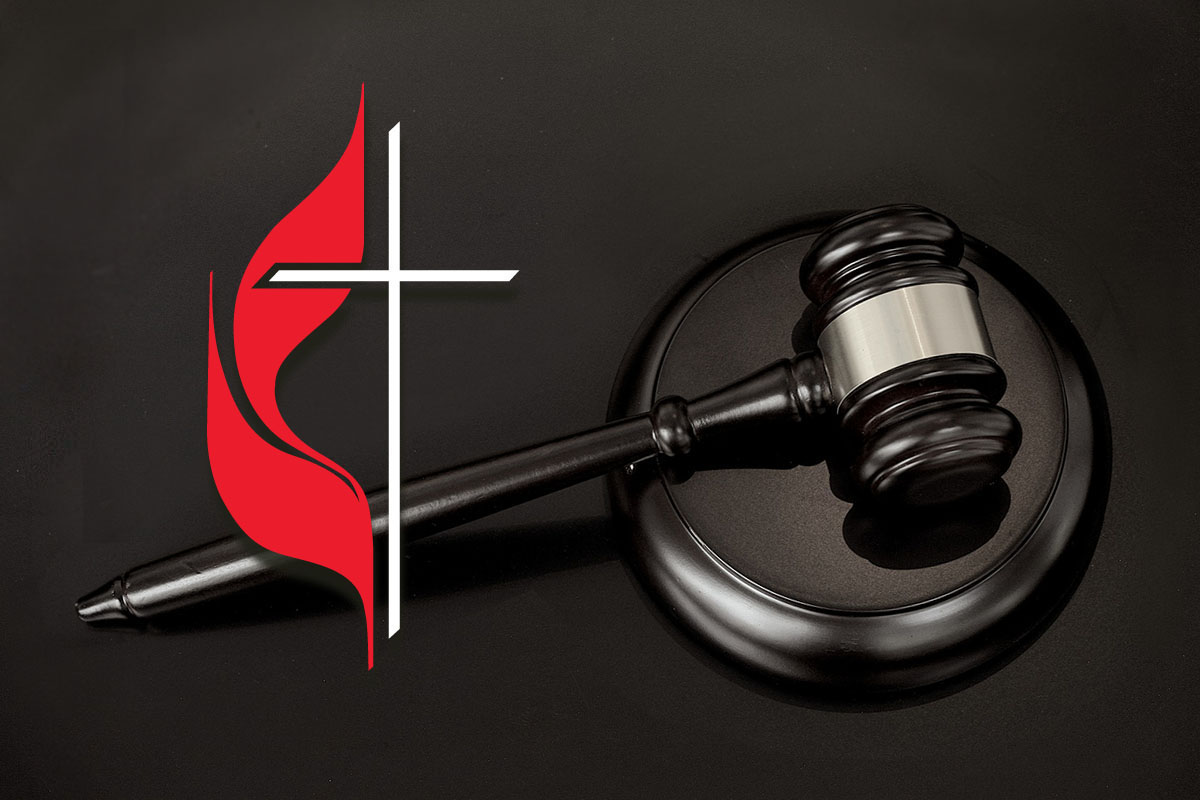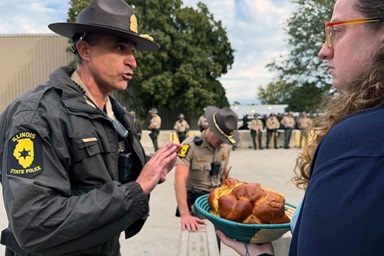Key Points:
- The Oklahoma Conference is appealing a judge’s order that it re-create its April special session to vote on a church’s disaffiliation.
- The judge specifically called on the conference to bring back voters who are no longer United Methodist. The conference says the order is an unconstitutional intrusion into church self-governance.
- The vast majority of withdrawing churches are following the denomination’s disaffiliation policy, but some cases are landing in civil courts.
A district court judge ordered the Oklahoma Conference to re-create its April 22 special session to vote on the withdrawal of a church that filed suit.
The order essentially requires the United Methodist regional body to hold what would be an illegal meeting under church law, the conference said.
The conference appealed the order to the Oklahoma Supreme Court, arguing that the judge’s order violates not only the denomination’s policies but also the U.S. Constitution’s First Amendment.
“The ruling blatantly interferes with an internal church process protected under the Free Exercise Clause of the First Amendment of the United States Constitution,” Oklahoma Conference Bishop Jim Nunn and other conference leaders said in a statement.
“It represents a threat to all institutions of faith because, if this ruling stands, no church or religious body is free from potential interference in its self-governance by secular courts.”
The Oklahoma Supreme Court on Aug. 2 granted the Oklahoma Conference's request for an emergency stay, pending the outcome of its appeal. That means the conference is canceling the special session that was called for Aug. 5. The emergency stay does not mean that the lower court’s ruling against the conference has been reversed. The state supreme court plans to hear oral arguments in the case later this month.
In an order filed July 25, Oklahoma County District Court Judge Aletia Timmons sided with First United Methodist Church in downtown Oklahoma City and said the conference had until Aug. 6 to hold a vote on the church’s disaffiliation.
The Oklahoma Conference already had another special session scheduled in October to take up more church disaffiliation resolutions, but the judge said that would not suffice.
“If this Court were to simply order that First Church be placed in the process for disaffiliation for possible consideration at the October 14, 2023, Special Annual Conference, First Church would be deprived of votes by delegates to the April 22, 2023, Special Called Annual Conference who have since disaffiliated and are no longer United Methodists,” Timmons wrote.
However, the conference’s leaders maintain that non-United Methodists should not have a vote or otherwise participate in any annual conference meetings. A big part of any annual conference is setting the bar — establishing where voting members sit and where others can observe from the sidelines.
“The ruling directs the conference to conduct its meetings in a manner that is contrary to the UMC’s governing laws and Constitution,” the conference said in a Frequently Asked Questions page about the case.
The judge’s ruling represents the latest flare-up as The United Methodist Church navigates a difficult stretch of church disaffiliations.
A look at other court cases
After decades of intensifying debates over LGBTQ inclusion, General Conference — the denomination’s top lawmaking assembly — passed a church law that offers U.S. congregations “a limited right” to exit the denomination with property if they meet certain financial and procedural obligations. That provision, the Book of Discipline’s Paragraph 2553, sunsets at the end of the year.
Since 2019, more than 6,000 United Methodist churches — about 20% of the denomination’s U.S. congregations — have cleared the necessary hurdles to leave with property under church law. That total includes 84 congregations that the Oklahoma Conference approved for disaffiliation in October last year and April this year.
The vast majority of churches leaving The United Methodist Church are following the denomination’s disaffiliation policy. But some cases are landing in civil courts — with unpredictable results.
The dispute between First United Methodist Church in Oklahoma City and the Oklahoma Conference is a case in point.
First United Methodist Church is among the traditionalist congregations seeking to disaffiliate under Paragraph 2553, due to concerns that The United Methodist Church might change its bans on same-sex weddings and noncelibate, gay clergy.
Among the provision’s requirements is that at least a two-thirds majority of professing members present support disaffiliation at a vote administered by the church’s district superintendent. District superintendents are clergy who serve on a bishop’s cabinet and help supervise the work of pastors.
The Rev. Victor McCullough, the church’s district superintendent at the time, scheduled the vote to take place on Jan. 22. Ahead of the church meeting, in line with disaffiliation procedures, McCullough asked for the church to share its membership roster. That’s when the dispute began.
First Church submitted a roster with 487 members listed and some 2,100 members removed by “correction” in its end-of-year report from December. The conference said that how the church handled this mass removal did not follow the Book of Discipline’s process for updating membership rolls.
“Within the context of the local church conference disaffiliation vote, this raises concerns of potential voter suppression and irregularity in the conduct of the vote,” the conference said in the FAQs document.
The conference added that it had raised concerns about First Church’s handling of its membership rolls multiple times in previous months.
The big drop in membership raised other alarm bells, too. The district superintendent notified the church that he was postponing the church vote until after the completion of a viability study of the church under the Discipline’s Paragraph 213, a process for assessing a local church’s potential.
The church balked at the delay and went ahead with a disaffiliation vote on Feb. 5 without a district superintendent present. The vote tally included 16 votes by email, which also is not in line with Paragraph 2553 requirements. But even without those 16 votes included, the judge’s order said, the church’s total tally showed the necessary support for disaffiliation.
Hardy Patton, a First Church member and spokesperson for the congregation, said the congregation saw the delay as reflecting an ulterior motive by the conference.
“The conference did not want us to disaffiliate,” Patton said. “There are 84 churches that have been through this process, and none of them had been denied.”
If the conference had not delayed the congregation’s vote back in January, he said, “we would have been disaffiliated in the April ratification process.”
Paragraph 2553 allows annual conferences to develop additional standard terms that are not inconsistent with the disaffiliation provision. The conference’s disaffiliation agreement sets as a condition that a district superintendent may require the church to undergo a viability study under Paragraph 213 prior to a church vote.
However, the judge in her order said the conference’s attempt to include the Paragraph 213 process in the middle of the disaffiliation process “is not consistent with the intent of ¶2553.”
Subscribe to our
e-newsletter
In its FAQs, the Oklahoma Conference said multiple churches in the conference have undergone a viability study as part of the disaffiliation process.
“In the event of a conclusion in the study that a church is not viable and the church still wishes to proceed with the disaffiliation process, the goal of the Oklahoma Annual Conference is to present the appropriate data to the entire conference so that the lay and clergy members have full information as they vote on ratification of that church’s disaffiliation in October 2023,” the conference said.
The judge’s order rejected the conference’s arguments and ruled that the conference had violated the denomination’s disaffiliation process.
Timmons wrote that “the failure of First Church to be presented to the April 22, 2023, Special Called Annual Conference caused First Church irreparable harm that will continue” without immediate relief.
In addition to requiring the conference to re-create its April 22 session, Timmons ruled that the conference may not complete a viability study of the downtown church and must recognize the Feb. 5 tally as an official vote for disaffiliation.
The conference said that all three of the judge’s orders violate the conference’s disaffiliation agreement, the Book of Discipline or both.
Throughout the court case, members of First Church in Oklahoma have maintained that this is a property dispute while the conference has maintained that this is a First Amendment issue. In its appeal to the Oklahoma Supreme Court, the conference argues that the judge’s order amounts to “an unlawful intrusion” into an internal church dispute.
Going back to the 18th century, The United Methodist Church and its predecessors have maintained a trust clause in the Book of Discipline that states that all church property is held in trust for the entire denomination. John Wesley, Methodism’s founder, established the forerunner to the Discipline’s current trust clause.
General Conference established Paragraph 2553 as a way for churches to gain a limited release from the trust clause under set conditions and in a set time period.
“The Oklahoma Annual Conference of The United Methodist Church will continue to fight to defend its rights as a religious organization and the rights of its members and local churches to the free exercise of their faith,” the conference said.
Hahn is assistant news editor for UM News. Contact her at (615) 742-5470 or newsdesk@umcom.org. To read more United Methodist news, subscribe to the free Daily or Friday Digests.




